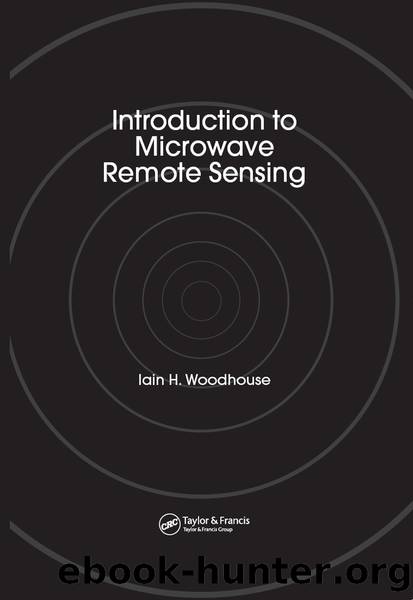Introduction to Microwave Remote Sensing by Iain H. Woodhouse

Author:Iain H. Woodhouse
Language: eng
Format: epub
Publisher: CRC Press
6.9.4 Strategies for Calibrating Receivers
There are two approaches to maintaining consistent and frequent calibration for passive systems: Dicke and total power radiometers. Both of them rely on making measurements relative to some known quantities in order to characterise the system complete with noise, since noise is not determinable theoretically.
In a total power radiometer the voltage output from the square-law detector is proportional to the total power through the system. The net IF power reaching the square-law detector can then be considered to consist of two components: that part proportional to the antenna temperature Ta and the internally generated noise power, or receiver temperature Tr, which is often predominantly electrical noise arising from individual components such as the mixer. The system temperature Ts is then defined as the sum of these components. In this case we expect the relationship between detected signal temperature and the actual brightness temperature to be linear, so that by using hot and cold targets with temperatures that cover the observed extremes, we assume that we can derive a linear relationship between the two.
Total power radiometer
A total power radiometer can then be calibrated by observing black-body emitters at two different temperatures. Assuming the radiometer is linear, which is usually the case to within practical limits, the antenna temperature for an unknown target is then determined from
Download
This site does not store any files on its server. We only index and link to content provided by other sites. Please contact the content providers to delete copyright contents if any and email us, we'll remove relevant links or contents immediately.
| Automotive | Engineering |
| Transportation |
Whiskies Galore by Ian Buxton(41937)
Introduction to Aircraft Design (Cambridge Aerospace Series) by John P. Fielding(33092)
Small Unmanned Fixed-wing Aircraft Design by Andrew J. Keane Andras Sobester James P. Scanlan & András Sóbester & James P. Scanlan(32764)
Craft Beer for the Homebrewer by Michael Agnew(18196)
Turbulence by E. J. Noyes(7977)
The Complete Stick Figure Physics Tutorials by Allen Sarah(7337)
Kaplan MCAT General Chemistry Review by Kaplan(6899)
The Thirst by Nesbo Jo(6877)
Bad Blood by John Carreyrou(6581)
Modelling of Convective Heat and Mass Transfer in Rotating Flows by Igor V. Shevchuk(6406)
Learning SQL by Alan Beaulieu(6237)
Weapons of Math Destruction by Cathy O'Neil(6214)
Man-made Catastrophes and Risk Information Concealment by Dmitry Chernov & Didier Sornette(5956)
Digital Minimalism by Cal Newport;(5704)
Life 3.0: Being Human in the Age of Artificial Intelligence by Tegmark Max(5514)
iGen by Jean M. Twenge(5385)
Secrets of Antigravity Propulsion: Tesla, UFOs, and Classified Aerospace Technology by Ph.D. Paul A. Laviolette(5333)
Design of Trajectory Optimization Approach for Space Maneuver Vehicle Skip Entry Problems by Runqi Chai & Al Savvaris & Antonios Tsourdos & Senchun Chai(5037)
Pale Blue Dot by Carl Sagan(4953)
